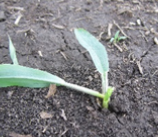The potential for substantial Black Cutworm (BCW) flight this growing season has been in the news. Thankfully, we can rely on our agricultural partner, DATCP! Many states do not have the luxury of a cadre of dedicated field personnel that regularly monitor and report on pests.
Although it is hard to know if these pheromone trap catches will result in field damage, here are a few important but condensed “bullets” to remember.
- There may be several BCW generations in WI. Field corn is only susceptible to the migrating (first) generation. Sweet corn’s range of planting dates is a different story.
- BCW adult females are attracted to the following sites to lay eggs. Good places to spot check: Fields with significant soybean residue, Low growing broadleaf weeds, or Low lying (wet) field areas.
- Larval ID. Up to 2 inches long. Often by damage found and by ruling out other insect pests. Few features/characteristics distinguish larva (see photo below).
- Adult ID is not important unless you are monitoring a black light and/or pheromone trap.
- Early detection is important. BCW larvae can cut several plants before pupating.
- BCW larvae usually are nocturnal feeders. Unless it is cool and cloudy.
- There are 7 larval instars. Larval cutting usually starts when at least ½ inch but depends on corn development. See A3646 for a larval head capsule (instar) guide and damage potential for corn.
- Damage symptoms. See photos.
- Larvae spend the day in the soil. Use a knife to slowly excavate soil from the base of the damaged plant and up to a 2 inch radius. Larvae are often found at the juncture of dry/wet soil.
- Economic threshold. WI threshold = 5% damaged plants. With current corn price, it is not advised to use a lower threshold. Also be able to find larvae in the field or do not treat. Check stage, if the population has pupated there is no way to prevent yield damage.
- Scouting: Assess damage accurately/unbiased. Count damaged plant numbers in 5 random sets of 50 plants. Spot treating may be possible if BCW populations are clumped in their distribution.
- Treatment: Many insecticides are labeled for black cutworm (cutworm, spp.) on corn. However, if using a synthetic pyrethroid (IRAC Class 3A) (i.e. Warrior II, Mustang, Brigade, etc.)., do not cultivate after treatment. These insecticides are bound by soil and control will be compromised. If considering using chlorpyrifos (Lorsban and other generic formulations), read both the insecticide and herbicide label first!! Potential crop damage many prohibit post emergence use. Other herbicide labels may have more restrictions on chlorpyrifos, as well.
- BCW Look a likes. Go to: http://ipcm.wisc.edu/blog/2015/05/black-cutworms-in-wi-corn/ for listing.
- Above ground traited corn: All should be scouted. The Cry1F and Vip3A are two proteins listing BCW control. However, under heavy populations significant damage may be seen.
- Other susceptible hosts: Many, including many vegetables (including sweet corn) and turf.
Modified by Dr. Loretta Ortiz-Ribbing from Dr. Byran Jensen, UW IPM Specialist—For the complete unabridged text go to: http://ipcm.wisc.edu/blog/2015/05/black-cutworms-in-wi-corn/.






